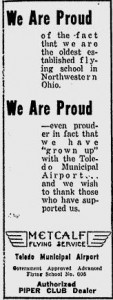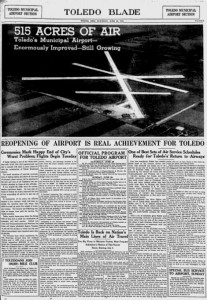What was going to be a simple post about the opening of Toledo Express Airport turned into something more complex when I discovered I couldn’t sum up in a sentence or two the history of the airport in Millbury, Wood County.
It’s gone by several names in its 80-plus years. It started out as Toledo Municipal Airport, became Metcalf Field, and is now known as Toledo Executive Airport, and its history turned out to be more interesting than its bigger, flashier counterpart out on Chicago Pike (which was what everybody called State Route 2 before it was Airport Highway).
The history of Toledo Executive Airport has been rough-and-tumble, to say the least, especially starting out (NOTE: I am resisting every urge to call it Metcalf Field, because that’s what I always knew it as).
The transatlantic flight of Charles Lindbergh’s brought the reality of aviation home to everybody, and it was not long after that Toledo’s leading citizens realized they needed a first-class airport. The Chamber of Commerce started a subscription drive. The News-Bee asked people to not think of the purchase of stock as a gift, but as an investment, in this January, 1928 editorial:
For every dollar put into the airport, the investor is to receive full value. Combined, the subscriptions will give the city an opportunity to gain the one great achievement that will set it in front rank, present and future. …
Hard-headed men, who deal in big affairs, and who do not invest their own money on a whim, have studied the airport carefully and pronounced the project sound. They do not guess. They know. Their judgment is backed up by facts.
And just as quickly, five months later, the airport opened on June 3, 1928 with 14-year-old Nan Beth Jackson, daughter of Mayor William T. Jackson, christening a National Air Transport plane “Miss Toledo” at the formal dedication attended by an estimated 30,000 to 50,000 persons.
But no hard-headed men anticipated the depression. The News-Bee took a look back at the airport’s turbulent depression years in 1936:
…For the first two or three years everything went smoothly. The depression hit aviation then, and use of the field dropped steadily. One day a flier took up a plane which has been stored in the airport hangar. It was in winter, some Army planes were getting ready to land, and the flier was going to guide them down. He cracked up the ship, and the people who had stored the plane brought suit against the airport. They got judgment for $9200 and, unable to pay it, the airport went into receivership.
The 1936 story was prompted by the unfortunate news that United Air Lines had complained the airport was below standard, especially at night, and announced it would suspend service unless adequate steps were taken.
Other cities were improving their airports with WPA money, but since Toledo’s airport was not owned by the city, no money was forthcoming. The city’s airport was falling behind. To remedy that, the city purchased the airport for $65,000 on Nov. 25, 1936, and floated a bond issue to help pay for a runway and lighting project.

The project didn’t end well. Disregarding the recommendations of a Cleveland engineering firm’s findings, the city skimped on repairs, which resulted in the runways buckling in 1938. Not soon after, United Air Lines said it was suspending service. Again.
So the city, with no usable municipal airport, went to Washington hat in hand for federal aid to rebuild the field. The negotiations went on for two years until the city and the government agreed on plans. Two concrete runways were built in 1940 for $275,000, but for two years, Toledo had no airport.

As the project neared completion, the Civil Aeronautics Board told the city that the two runways would only work for limited service and another $300,000 worth of construction was needed: an additional runway, improved lighting system, and more aprons and taxiways.
It reopened on June 29, 1941, and The Blade was so happy they published a special eight-page section about it.
Its future as a major airport didn’t last long, however. After World War II ended, the city almost immediately started kicking around ideas for a new airport or expanding the old one. Air travel was a major focus of the 1945 Toledo Tomorrow exhibit, which suggested five airports around Toledo, and with air travel expanding and planes getting larger, the city needed a Class V airport (a Class V airport was, in the late 1940s anyway, one with runways of 5,500 to 6,500 feet, including at least one paved runway).
Expanding the Municipal Airport was ruled out when the Pennsylvania Railroad refused to budge on the relocation of their tracks.
In 1955, commercial aviation in Toledo switched to the new Toledo Express Airport, making the old Municipal Airport useful for private and business aviation but not much more. In the 1960s, Metcalf became a hotspot for drag racing according to this interesting story from “The Press,” a paper out in Millbury I never heard of.
In a deal with the Toledo-Lucas County Port Authority in late 1972, the city retained ownership of both airports and leased them to the Port Authority for $1 a year. The authority took it over the next year and it’s still operated by them today. The airport was named Metcalf Field in 1977 after Thomas Metcalf, Toledo’s first commissioner of aviation, and president and owner of the Metcalf Flying Service at the airport from 1930-1950. It got its new name in 2010.

I heard they uncovered Timber Rattlers when the airport was first built. Is this true. I don’t live that far from the airport.
Yes. At least for the airport on Airport Highway. My Grandfather was one person trying to clear the trees away. He said the Timber Rattlers grabbed ahold of the big treads of the tractor tires. He jumped off and ran as far as he could and never came back to finish that project.
Timber rattlers are all over Ohio. Take a walk along Swan Creek and you will find Cotton Mouth and Timber Rattlers along with non-poisonous species. I used to catch them when I was a kid all the time in the ’50s along Swan Creek by Highland Park at South Street. If the creek is there, so are the snakes.